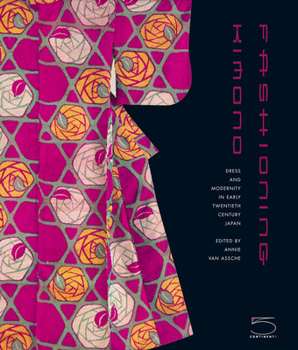Fashioning Kimono
Fashioning Kimono focuses on 150 Japanese garments dating from the late 19th to the early 20th centuries, taken from the renowned Montgomery Collection, which includes informal kimonos for both women and men, haori jackets, under-garments, ceremonial and formal clothes, and children's robes. Some of the designs reflect historical continuity, but many others demonstrate a radical break from the traditional. Themes and designs from Western art predominate...
Format:Hardcover
Language:English
ISBN:8874392710
ISBN13:9788874392711
Release Date:September 2005
Publisher:5 Continents Editions
Length:336 Pages
Weight:4.10 lbs.
Dimensions:1.2" x 9.6" x 11.6"
Customer Reviews
5 ratings
Stunning Photographs and a great text!
Published by Thriftbooks.com User , 15 years ago
This book was given as a gift to a Japanese American family. Their daughter is studying in art school. The photographs are stunning and the text is excellent. The book was a big hit.
Beautiful Book of Kimono
Published by Thriftbooks.com User , 16 years ago
This book is beautifully produced with an excellent history of kimono plus many pages of designs, including children's and men's as well as obi, from the past 100 years. Many of the kimono designs are very "art-deco" which might turn off some who like plainer styles. But to my mind the colors and patterns are fabulous! Just look at the front cover image to get a sense of how rich these designs are.
Wanting more
Published by Thriftbooks.com User , 17 years ago
The first fourth of the book contains a lot of valuable information about styles and techniques, then the rest is page after page of photos. Beautiful photos, but I wish there was more discussion about cultural significance of the designs depicted.
A VIRTUAL PANOPLY OF COLOR, ART, AND HISTORY
Published by Thriftbooks.com User , 18 years ago
"Fashioning Kimono" is a virtual panoply of color, art, and history focusing on kimono from the vast collection of Jeffrey Montgomery. Among the 1200 rare objects in Montgomery's enviable collection are these 150 kimono dating from the late nineteenth to the mid twentieth centuries. It is an array comprehensive in scope with kimono and haori jackets worn by men, women and children. The almost 200 photographs of the textiles by Stefano Ember are stunning - bold, aresting in hue, delicate as a butterfly's wing in design. Publication of this volume accompanies an exhibition of the same name at the Victoria and Albert Museum in London, which runs from mid October of this year through May 1, 2006. Annie Van Assche, the editor and primary author, presents a history of the kimono, while additional essays include such topics as new styles based on Art Nouveau and Art Deco designs, the kimono's influence on Parisian fashion, and the fascinating memoir of a Japanese girl growing up in the 1930s and 1940s. As Van Assche notes silk is at the very heart of the Japanese kimono culture. It's strength, sheen and adaptability to dyes make it the ideal material. The inspired use of color, we learn, may be due in part to the fact that in ancient times the Japanese believed "color imbued a garment with special powers." All with an interest in fashion, design and the Japanese culture will find "Fashioning Kimono" an indispensable addition to a personal library. - Gail Cooke
flowering of the Japanese kimono in its last years
Published by Thriftbooks.com User , 18 years ago
The early decades of the 1900s were the final flowering for the Japanese kimono, the standard clothing for men and women going back for centuries. This was literally so for many kimonos; for they have bright, sometimes lavish, flower patterns and images from the influences of the Western art styles of art nouveau and even art deco. The growing modernization and Westernization of Japan at this time was seen in the changing patterns in the kimono. The stylistic innovations came to an end with the turn to Western clothing after Japan's defeat in WWII and the destruction of the country's industry. One hundred and fifty modern kimono from about the 1890s to the 1930s from the collection of Jeffrey Montgomery are shown in color photographs with close-ups of the details of a few. The photos are full-page on the right with notes on the facing page. The book is done in conjunction with an exhibition of the collection at the Victoria and Albert Museum through May 2006. The beginning essay by editor and contributor Annie Van Assche--textile artisan, Japanese art historian, and one-time curator of education for the Japan Society Gallery in New York--is an outstanding brief course on the artistic aspects, manufacture, and types and eras of kimono while serving as a lead-in to the following four essays taking up different topics regarding its final, modern, period.




